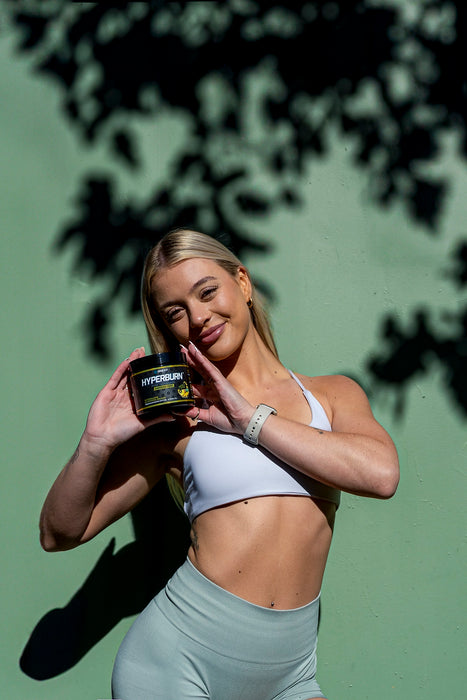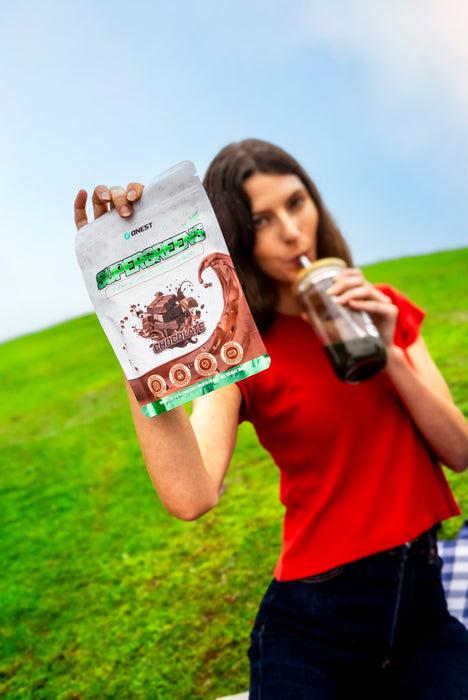CALORIE DEFICIT: WHAT IS IT & HOW CAN YOU SUPERCHARGE YOUR RESULTS?
You’ve no doubt heard about calories in, calories out. The mantra that’s long been plastered throughout the media and the mainstream…
But what is an actual calorie deficit?
How do you reach one and settle in comfortably to maintain this lifestyle adjustment?
Are there any products that can supercharge this process, ease your path, and make weight loss more straightforward and sustainable?
This article covers everything you need about calories and how to create a successful deficit.
What are calories?
Understanding calories is vital to successfully managing your weight, waistline, and overall well-being. So, what exactly are calories?
Simply put, they are units of energy we receive from the foods and drinks we consume. Every action — from the simplest activities like breathing or watching TV to more intense ones like a heavy gym workout or running a marathon — requires energy, i.e., calories.
Calories come from three main macronutrients: carbohydrates, fats, and proteins. While carbs and proteins provide four calories per gram, fats pack more than twice that amount — nine calories per gram.
This doesn’t make fats the story’s villains; far from it. Fats play essential bodily roles, including hormone production and nutrient absorption. You need fats to stay healthy.
If you’re seeking a calorie deficit, though, it does mean you should be mindful of your intake. The fats, carbs, and proteins you eat should make the most of their calories. They must be high quality and health-promoting. No trans fats, no refined sugars, and no junk!
What is a calorie deficit?
While the reality is more complex, part of weight loss includes the number of calories you consume versus the number you expend.
When caloric intake matches the number of calories we expend daily — through essential bodily functions and physical activities — we maintain our weight. This state is known as caloric balance.
But when there’s an imbalance?
If we continue to consume more calories than we burn — a state known as “caloric surplus” — we store the extra energy as fat. Over time, this leads to love handles, belly fat, and general weight gain.
On the flip side, when we use more energy than we take in, the body turns to its stored fat reserves for fuel, resulting in weight loss. This is known as a “calorie deficit.”
As mentioned above, the equation isn’t quite this simple. However, “calories in, calories out” are crucial in effectively burning body fat, fine-tuning your aesthetic, managing your weight, and maintaining good health.
Imagine a calorie bank account
Just as someone might have a financial deficit or surplus, a similar dynamic can occur with calories.
Here, ‘spending’ refers to burning calories through basal metabolic rate (BMR), the digestion of food, and physical activity. ‘Earning,’ on the other hand, is about the intake of calories from the food and drinks we consume.
You enter a calorie deficit when your body spends more calories than it earns. This means more energy is used (“burnt”) than received from food and drink. Because you still need fuel to run you, you tap into your stores of fat to shore up the shortfall.
You lose weight as your body breaks down its fat stores for extra energy. In other words, creating a consistent calorie deficit is a key to weight loss.
While the concept of a calorie deficit sounds simple, it’s crucial to implement it thoughtfully and carefully. Dramatically slashing your calorie intake or rigid boot camp regimes can lead to failure, an unhealthy relationship with food, physical injuries, and guilt, potentially reinforcing a yo-yo cycle.
The trick is to find the right balance between reducing your caloric intake and increasing your physical activity to create a sustainable calorie deficit.
Calorie deficit in action: Eating for success
Creating a calorie deficit doesn’t necessarily mean you have to eat less – just smarter.
By focusing on nutrient-dense foods that are high in fiber and lean proteins but lower in calories, you can feel full without exceeding your calorie limit. Think vegetables, fruits, lean proteins, and whole grains.
Want some delicious inspiration?
Check out these recipes:
— Roasted pumpkin and quinoa salad
— Healthy & glowing skin salad
Calorie deficit in action: Exercising for success
You can and should use exercise to your caloric advantage. Incorporating physical activity into your days will burn energy naturally. Building your muscle mass will boost your baseline metabolism. Your ability to burn more calories at rest. That means you’ll chew through more body fat, even while you’re sleeping!
Skeletal muscle — the muscles that move you — also help to maintain healthy blood glucose control. As you build your tone, you diminish your risk of insulin resistance. And with it, fatigue, diabetes, and other chronic illnesses, which make it harder to lose fat and maintain a slim physique.
So, what exercise should you perform?
-
Resistance training.
-
High-intensity work (for example, a 30-second all-out cycling sprint, four-minute rest, repeat three times. Perform several times per week).
-
Any exercise you enjoy because you’re infinitely more likely to make it part of your lifestyle permanently. Cycling, dance, gym, swimming, walking. What’s your fav?
How can you determine your calorie balance?
Great, you’re ready to begin. But how can you determine what a calorie deficit would be?
The only way to know for sure is to undergo clinical testing. However, a BMR calculator is a helpful tool. Considering your gender, age, height, weight, and activity level, it’ll give you a baseline. An estimate for the daily calories required to maintain your current weight.
Depending on the calorie deficit you want, divide this appropriately. For example, to create a 20% calorie deficit from a maintenance intake of 2,000 calories daily: 2,000 x 0.8 equals 1600 calories per day.
Know, though, that this isn’t necessarily accurate for you. If you aim to shed pounds, track your food intake and exercise. If, after a time, the fat isn’t shifting, your BMR calculation may be inaccurate. Trial increasing your calorie deficit.
Tip: Stay away from a cycle of too few calories. This can lead to losing muscle mass, food pangs, lack of sustainability, falling off the wagon, and weight rebound. It’s also just plain unpleasant.
How can you effortlessly enhance your calorie deficit?
Natural compounds can help you stay in a calorie deficit in various ways.
Capsicum extract aids an increased metabolism, fat burning, and reduced hunger.
Bitter orange extract ramps up metabolism and suppresses appetite.
Caffeine anhydrous and dicaffeine malate boosts resting energy expenditure and promotes the breakdown of fat.
L-carnitine tartrate and acetyl-l-carnitine enhance the ability to use fat as energy, increase endurance to exercise for longer, and encourage weight loss.
L-Theanine improves mood, so you’re less likely to comfort eat.
That’s why each compound is included in our unique HyperBurn formulation: To get you results!
As Richard H. said, “This is the best fat burner I’ve tried, hands down. Since starting it 4 weeks ago, I’m down 4lbs. Finally, a supplement company to be excited about!”
Unleash your fat-burning potential with HyperBurn. Get started on your successful fat loss journey!






